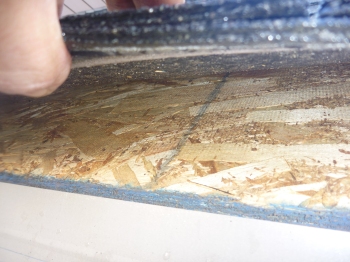The other day I helped a client with an unfortunate situation: her home’s roof was leaking.
The worst part of this issue was the fact that she had paid roofers to find and repair this leak multiple times.
This last summer she even had the drywall repaired under the leak figuring that the roofers had actually done what they had been paid to
do.
By the time she got a hold of me, she had reached the end of her
rope and was on the edge of tears. I told her that I would be happy to
come to do an inspection to locate the leak and hopefully give her some unbiased answers.
When I got to her home, she showed me the areas of concern. I crawled up into her attic and there was little doubt as to the source of the leakage.
The valleys were soaking wet.


Roofing like other construction trades is pretty straightforward but certain techniques must always be adhered to. The installation guidelines must be strictly followed.
Something as simple as an additional bevel cut into the end of a shingle can be the difference between proper installation and leakage.
There are many different ways to do a proper valley installation. Each style has its own particular guidelines.
This particular home had a “Closed cut valley.”
-1. The first part of this installation is the lining of the valley with an additional layer of building paper or metal liner. This layer
serves to be a ‘last line of defense if all of the other layers of
protection fail.
-This step was likely neglected in this particular
roof.

-2. The next step is that one entire roof slope (the smaller section of the roof or lower slope) of shingles should be installed completely and extended past the center line by at least 12 inches.
-It is difficult to determine if this guideline was followed.
-3. The next step is to roof the other adjoining roof slope. Along with this step, the top edge of the shingles must be cut back and beveled to prevent water infiltration. The acute angle that is at the tips of these extended shingles may
act as a scoop and funnel if they are not provided with an additional
cut to bevel this edge.
-This step was neglected on this roof.
-4. When all of the shingles that are close to the valley are fastened to the roof it is important to hold the
fasteners away from the center line of the valley at least six inches.
-This step was also not adhered to precisely.
The bad news is that my client has some work ahead of her. She is not quite ready to sell, and the rest of her roof has at least 5 more good years of service. It is not a great financial decision to properly repair the valleys since the rest of her roof will need replacement shortly. So, what kind of patching options are there?
Since the valleys are the issue, it is possible to seal the leaks with a generous coat of tar. However, most tar (flexible asphalt-based sealers) are recommended to be installed when the surface is dry. With a little research, I found this stuff:
 http://www.dewittproducts.com/catalog.asp?prodid=627618&showprevnext=1
http://www.dewittproducts.com/catalog.asp?prodid=627618&showprevnext=1
This product claims that it is specially formulated to be installed on wet surfaces! Sounds pretty good to me!
Just remember that the tar is a TEMPORARY SEAL!!! This is an important point and as long as a good layer is reapplied in the summer my client should be leak-free until she is ready to replace the entire roof.
Powered by ScribeFire.













 r roof!!
r roof!!


 lls.
lls.